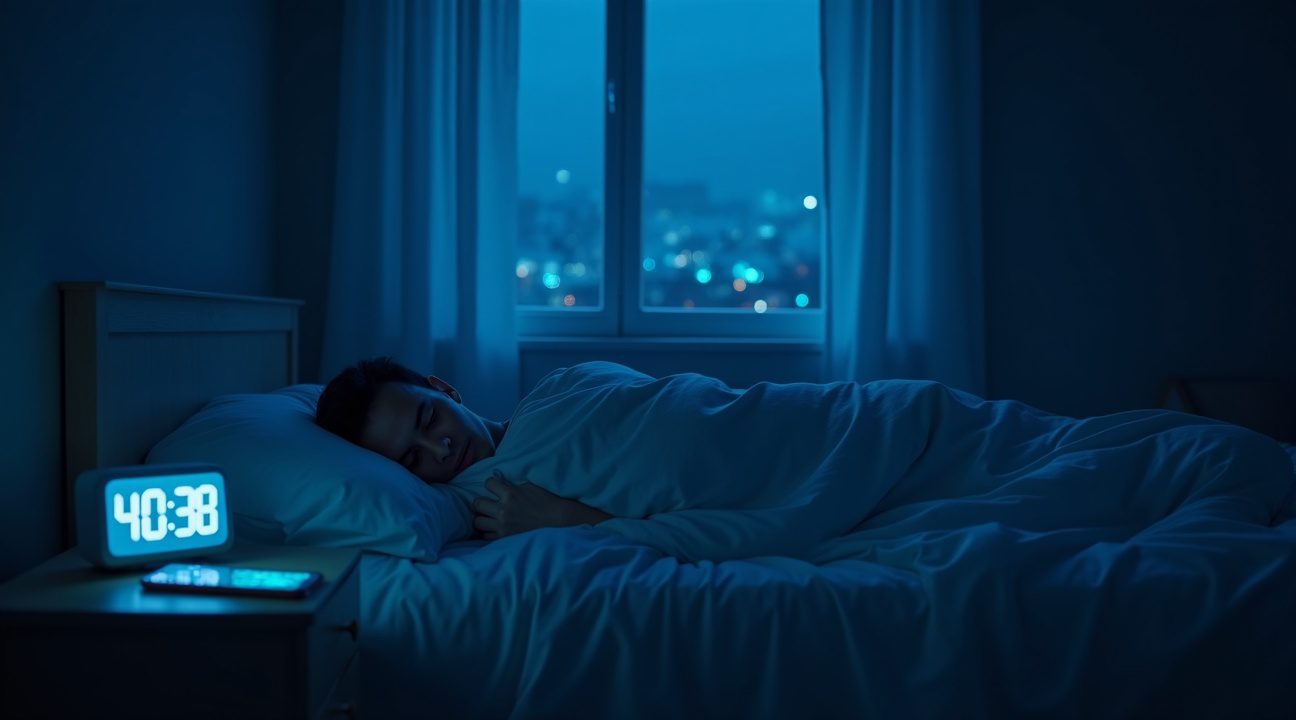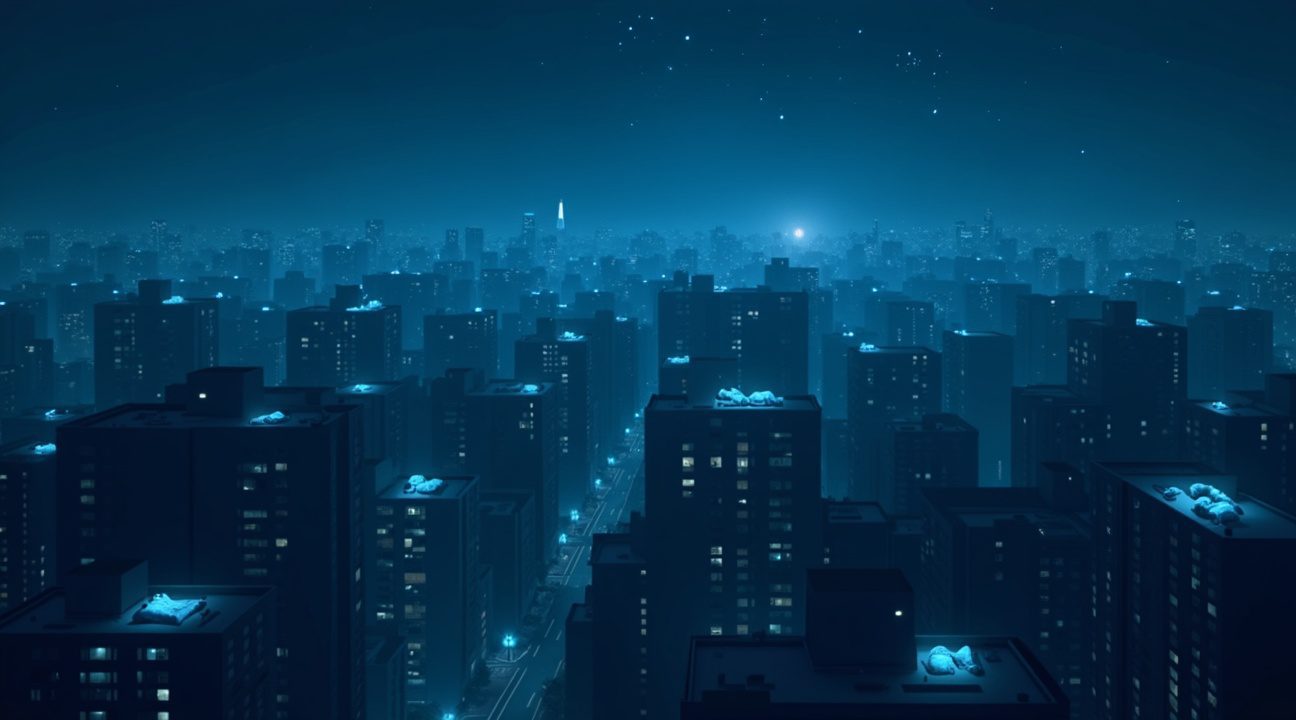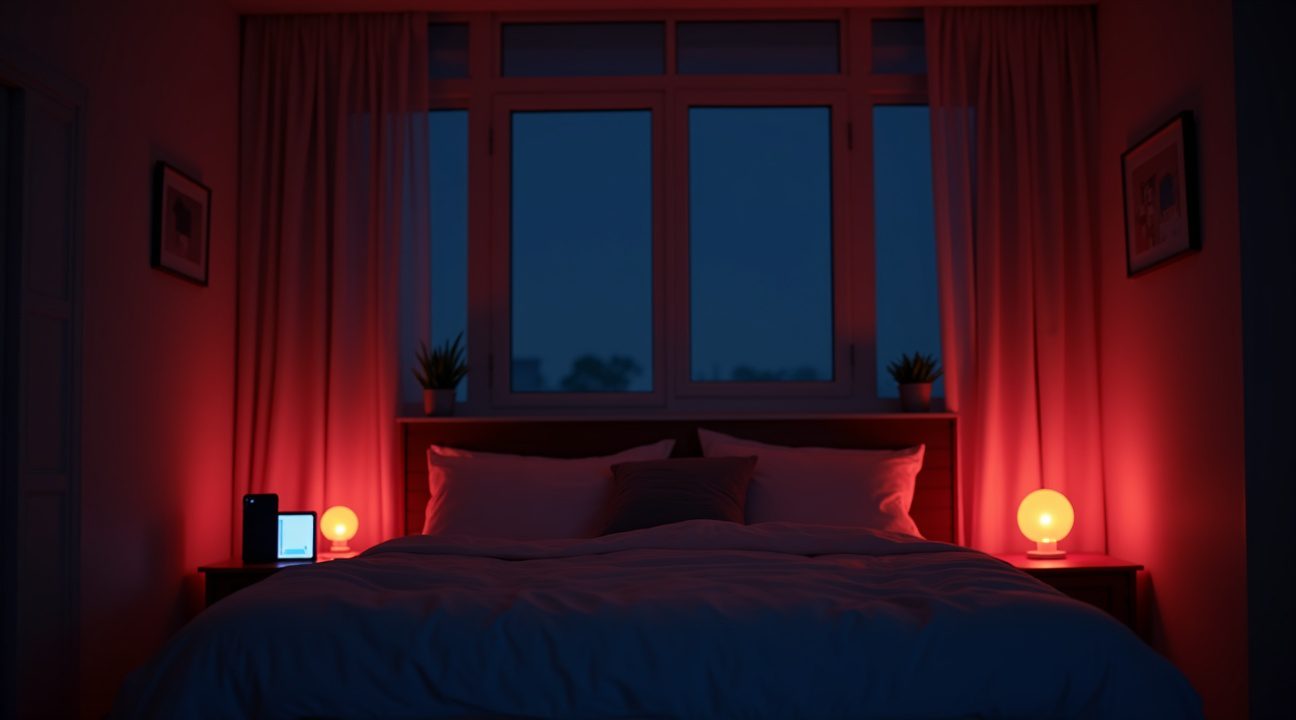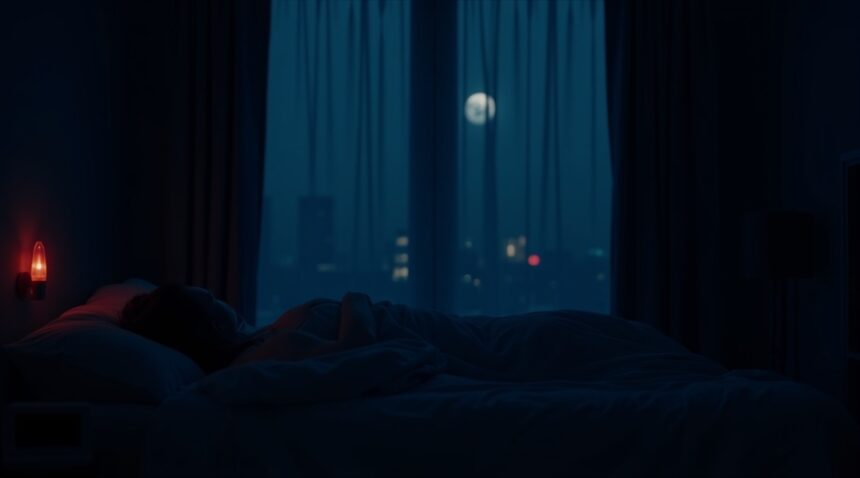Recent research shows that exposure to just 40 lux of light during sleep—equivalent to a dim night light or bright moonlight—significantly disrupts the brain’s essential recovery processes and cognitive restoration.
Key Takeaways
- Even minimal light exposure of 40 lux during sleep disrupts brain recovery, causes shallow sleep cycles, and reduces cognitive performance.
- Common household light sources like digital clocks, charging phone indicators, and streetlights filtering through curtains can reach problematic levels of illumination.
- Children and teenagers face heightened vulnerability to nighttime light due to their developing nervous systems and increased sensitivity to circadian disruption.
- Light exposure during sleep suppresses melatonin production and can lead to long-term health consequences including metabolic disorders, mood problems, and cardiovascular risks.
- Creating complete darkness through blackout curtains, covering electronic indicators, and using red-toned lighting in the evening can significantly improve sleep quality.
The Brain’s Need for Darkness
The human brain requires complete darkness to initiate its most critical restoration processes. Sleep specialists have discovered that even tiny amounts of light can trigger physiological responses that prevent deep, restorative sleep. Digital displays, LED indicators, and ambient outdoor lighting create an environment that keeps the brain in a state of partial alertness.
How Light Affects Circadian Rhythms
Circadian rhythm disruption begins with surprisingly low light levels. The retina contains specialized cells called intrinsically photosensitive retinal ganglion cells that detect light and send signals directly to the brain’s master clock. These cells remain active even when the eyes appear closed, continuously monitoring for any light presence. A charging phone’s indicator light or an illuminated smoke detector can provide enough stimulation to suppress melatonin production.
Heightened Risk for Children and Teens
Children and adolescents show heightened sensitivity to artificial light during sleep hours. Their developing nervous systems require deeper sleep phases for proper brain development, memory formation, and emotional regulation. Blue light exposure from screens before bedtime compounds the problem by shifting their natural sleep schedules later. Many parents don’t realize that common bedroom electronics create enough light pollution to affect their child’s development.
Sleep Disruption and Cognitive Impact
Sleep quality deteriorates measurably when exposed to minimal light sources. Brain wave studies reveal that people sleeping in rooms with 40 lux of light spend less time in slow-wave sleep, the deepest and most restorative phase. Memory consolidation suffers as the hippocampus struggles to transfer information from short-term to long-term storage. Cognitive performance drops the following day, affecting attention, decision-making, and emotional regulation.
Strategies for Optimal Sleep Environments
Creating an optimal sleep environment requires attention to detail and strategic planning. Blackout curtains eliminate outdoor light sources like streetlamps and early morning sun. Electrical tape over LED indicators on electronics removes small but disruptive light sources. Red-filtered nightlights provide safety illumination without triggering circadian disruption, as red wavelengths have minimal impact on melatonin production.
Room Darkness Audit
Sleep specialists recommend conducting a darkness audit of bedrooms. This involves lying in bed with lights off and identifying any visible light sources. Phone chargers, cable boxes, air purifiers, and clock displays often contribute more illumination than expected. Smart home devices with always-on displays can create particularly problematic light pollution throughout the night.
Health Risks of Nighttime Light Exposure
The cumulative health effects of chronic light exposure during sleep extend far beyond temporary fatigue. Studies link nighttime light pollution to increased risks of depression, anxiety, and seasonal affective disorder. Metabolic dysfunction occurs when circadian rhythms become disrupted, leading to weight gain, insulin resistance, and diabetes. Cardiovascular health suffers as blood pressure regulation and heart rate variability become impaired.
Professional Recovery Practices
Professional athletes and performance specialists prioritize complete darkness for optimal recovery. Elite competitors use blackout rooms, eye masks, and careful light management to maximize their sleep quality. These same principles apply to anyone seeking better cognitive function, emotional stability, and physical health. Small changes in bedroom lighting can produce significant improvements in sleep quality and overall well-being.
Tech Solutions for Better Sleep
Modern technology offers solutions for maintaining darkness while preserving functionality. Motion-activated red lights provide safe navigation without circadian disruption. Smart bulbs can automatically dim and shift to warmer tones as bedtime approaches. Sleep tracking devices now include light sensors to help identify problematic illumination sources in sleeping environments.
Even 40 Lux Can Shatter Your Brain’s Nightly Recovery
I’ve discovered that even the smallest amount of light during sleep can sabotage the brain’s essential recovery processes. The latest research reveals that exposure to just 40 lux—roughly equivalent to a dim night light or bright full moon—significantly disrupts sleep quality and cognitive restoration.
Light Pollution Creates Shallow Sleep Patterns
Study participants who slept under these minimal light conditions experienced notably shallower sleep cycles compared to those in complete darkness. Their sleep patterns showed increased nighttime arousals, preventing the deep, restorative phases that the brain requires for optimal function. These disruptions might seem minor, but they accumulate over time to create significant deficits in cognitive performance.
Brain oscillations that facilitate memory consolidation and support crucial cognitive functions were markedly decreased when participants slept under light exposure. These oscillations represent the brain’s way of organizing and storing information from the day, transferring memories from temporary to long-term storage. Without adequate darkness, this critical process becomes compromised.
The research also demonstrated that light exposure suppressed melatonin production, the hormone responsible for regulating sleep onset and maintaining proper sleep phases. Participants took longer to fall asleep and reported reduced morning alertness, creating a cascade of sleep-related problems that extended well beyond bedtime hours.
Consider how common sources of 40 lux exposure include streetlights filtering through curtains, electronic device standby lights, digital alarm clocks, or bathroom night lights left on for safety. Many people don’t realize that sleeping with your charging phone nearby can contribute to this problematic light exposure, especially if the device has bright indicator lights or the screen activates during the night.
The implications extend beyond simple tiredness. When melatonin production becomes suppressed night after night, the body’s natural circadian rhythm shifts, making it increasingly difficult to maintain consistent sleep schedules. This disruption affects hormone regulation, immune function, and metabolic processes that depend on proper sleep cycles.
Steps to Improve Sleep Quality
I recommend evaluating your sleep environment for any sources of light that might reach 40 lux or higher. Simple changes can make a big difference:
- Use blackout curtains to block outdoor light
- Wear an eye mask to shield against indirect light
- Turn off or cover electronic device indicator lights
- Remove digital alarm clocks with bright displays
- Choose dim red night lights if illumination is needed
Even small LED indicators on electronics should be covered or turned away from the sleeping area.
The study’s findings emphasize that complete darkness isn’t just preferable—it’s essential for optimal brain function. Your cognitive performance, memory consolidation, and overall sleep quality depend on maintaining an environment free from even minimal light intrusion during sleep hours.

How Light Hijacks Your Internal Clock at the Worst Possible Time
Light acts as a powerful drug for the brain’s circadian clock, and artificial illumination at night delivers this drug at precisely the wrong moment. The circadian clock operates as a biological system that governs sleep-wake cycles, and it remains remarkably sensitive to both the intensity and timing of light exposure throughout the day and night.
Understanding the Phase Response Curve
The Phase Response Curve reveals how drastically light can shift sleep patterns depending on when exposure occurs. Morning light typically advances the sleep cycle, causing people to wake earlier and feel tired sooner in the evening. Nighttime light creates the opposite effect, delaying the natural sleep cycle and pushing bedtimes later while making morning wake-ups more difficult.
This timing sensitivity explains why sleeping with your charging phone nearby can create such persistent sleep problems. Even small amounts of light from device screens or charging indicators hit the circadian system during its most vulnerable hours, when darkness should signal the brain to maintain deep rest.
Blue Light and Melatonin Suppression
Blue-enriched light poses the greatest threat to healthy sleep patterns. Screens and LED lights emit high concentrations of blue wavelengths, which suppress melatonin production more aggressively than other light colors. This suppression doesn’t require bright illumination— even brief or dim light exposure can shift circadian timing or reduce melatonin levels significantly.
The brain interprets any light exposure during sleep hours as a signal to reduce melatonin production. This hormone serves as the body’s natural sleep signal, and its suppression creates a cascade of sleep disruption that extends far beyond the initial light exposure. Modern LED technology, while energy-efficient, delivers concentrated doses of blue light that can penetrate closed eyelids and continue affecting the circadian system.
Artificial lighting creates an especially problematic scenario because it delivers light at consistent intensities throughout the night. Unlike natural moonlight, which varies in brightness and doesn’t contain high levels of blue wavelengths, artificial sources maintain steady output that continuously signals the brain to remain alert.
The circadian clock evolved over millions of years to respond to natural light patterns, making it particularly vulnerable to modern lighting conditions. Even minimal artificial light exposure—such as streetlights filtering through curtains or the glow from electronic devices—can shift sleep timing by minutes or hours, depending on the duration and intensity of exposure.
Research demonstrates that light exposure during sleep doesn’t just affect immediate rest quality. These disruptions accumulate over time, gradually shifting the entire sleep-wake cycle and making it increasingly difficult to maintain consistent sleep schedules. The brain’s internal clock becomes confused about appropriate timing for sleep and wake periods, leading to chronic sleep difficulties that persist even when light sources are removed.
The sensitivity to light varies throughout the night, with certain hours presenting higher vulnerability to circadian disruption. Late evening and early morning hours create the strongest response to light exposure, while mid-sleep periods show slightly less sensitivity. However, any artificial light during designated sleep hours can trigger measurable changes in brain activity and hormone production.
This biological vulnerability to light makes bedroom environment control critical for maintaining healthy sleep patterns. Complete darkness during sleep hours allows the circadian clock to function properly, supporting natural melatonin production and enabling the brain to complete essential restoration processes that occur during different sleep stages.
The Hidden Health Crisis Lurking in Light Pollution
Light pollution isn’t just an aesthetic concern for stargazers anymore. I’ve discovered that chronic exposure to artificial light during nighttime hours creates a cascade of serious health problems that extend far beyond simple sleep disruption. The widespread illumination of our cities and homes has fundamentally altered how our bodies function at the most basic biological level.
The health consequences of nighttime light exposure reach deep into our metabolic systems. Chronic light-at-night exposure disrupts insulin sensitivity and glucose metabolism, creating conditions that can lead to diabetes and obesity. I’ve found that even low levels of artificial light interfere with the body’s natural hormone production, particularly affecting cortisol and growth hormone cycles that are essential for cellular repair and regeneration.
Mental health suffers significantly under constant light exposure. Depression rates climb in populations exposed to high levels of nighttime illumination, as the disrupted circadian rhythms interfere with serotonin and melatonin production. Mood disorders become more prevalent when the brain can’t properly distinguish between day and night cycles, leading to emotional instability and increased anxiety levels.
Cardiovascular risks escalate dramatically with prolonged light exposure during sleep hours. The heart’s natural rhythm depends on circadian cues, and artificial light confuses these signals, potentially increasing blood pressure and heart rate variability. This disruption can contribute to higher rates of heart disease and stroke over time.
Perhaps most concerning is the potential connection between circadian disruption and cancer risk. The body’s natural cancer-fighting mechanisms rely heavily on proper melatonin production, which occurs primarily in darkness. When artificial light suppresses melatonin synthesis, it may compromise the immune system’s ability to detect and eliminate abnormal cells.
The Widespread Impact on Sleep Quality
Epidemiological studies paint a troubling picture of how light pollution affects entire populations. Individuals living in areas with high outdoor light pollution consistently report shorter sleep duration compared to those in darker environments. The correlation between urban lighting and sleep problems isn’t coincidental—it represents a fundamental conflict between modern infrastructure and human biology.
I’ve observed that people in brightly lit urban areas experience several specific sleep-related problems:
- Significantly reduced total sleep time, often losing 30–60 minutes per night
- Higher rates of insomnia and difficulty falling asleep initially
- More frequent nighttime awakenings and fragmented sleep patterns
- Increased daytime sleepiness that affects work performance and safety
- Delayed sleep phase syndrome, where natural bedtime shifts later and later
The cognitive toll of poor sleep quality from light exposure manifests in multiple ways. Concentration becomes increasingly difficult as the brain struggles to maintain focus without adequate rest. Memory formation and consolidation suffer when sleep cycles are repeatedly interrupted by light exposure, making it harder to learn new information and retain important details.
Mood instability emerges as another significant consequence of light-disrupted sleep. The brain’s emotional regulation systems depend on proper rest cycles to function effectively. When artificial light interferes with these processes, people experience increased irritability, emotional volatility, and difficulty managing stress.
The modern habit of sleeping with your charging phone nearby compounds these problems, as device screens emit blue light that particularly disrupts melatonin production. Even small amounts of light from electronics can trigger the brain’s wake response, making it nearly impossible to achieve the deep, restorative sleep necessary for optimal health.
This health crisis extends beyond individual consequences to create broader societal impacts. Reduced cognitive function and increased illness rates strain healthcare systems and decrease overall productivity. The solution requires both personal awareness and community-level changes to lighting practices that prioritize human health alongside urban development.

Why Children and Teens Face the Greatest Risk from Nighttime Light
Young people’s developing brains demonstrate exceptional vulnerability to even minimal light exposure during sleep hours. This heightened sensitivity occurs because neural pathways are still forming and consolidating, making them more susceptible to environmental disruptions that can alter crucial developmental processes.
Critical Hormonal Disruptions in Developing Brains
Animal model studies reveal alarming evidence about nighttime light’s impact on young, developing nervous systems. Research conducted on chicks shows that just one hour of light exposure at night can significantly alter the release of essential hormones. These studies demonstrate disruptions in melatonin production, the primary sleep-regulating hormone, alongside changes in allopregnanolone (ALLO) levels, which plays a vital role in neural development and brain plasticity.
The implications extend far beyond temporary sleep disturbances. Scientists have discovered that these hormonal alterations don’t simply reset once normal darkness returns—they can persist well into adulthood, potentially affecting long-term brain function and emotional regulation. This persistence suggests that nighttime light exposure during critical developmental windows may create lasting changes in neural architecture.
Heightened Vulnerability in Specific Populations
Children and adolescents naturally exhibit increased sensitivity to nighttime light compared to adults. Their circadian systems are still maturing, making them more reactive to environmental light cues that can throw off their internal clocks. This biological reality becomes particularly concerning when considering how many young people sleep with devices nearby or in rooms with ambient light from various sources.
Individuals with mood disorders face compounded risks from nighttime light exposure. Their already-vulnerable emotional regulation systems become even more disrupted when exposed to light during sleep hours. The combination of developing neural pathways and existing mood vulnerabilities creates a perfect storm for both developmental and emotional disturbances.
Parents should be especially vigilant about sleeping with your charging phone or other light-emitting devices in children’s bedrooms. Even the small LED lights from charging cables or standby indicators can provide enough illumination to trigger these problematic hormonal responses.
The teenage years present additional challenges since adolescents naturally experience shifts in their circadian rhythms that make them want to stay up later and sleep in longer. When combined with increased light sensitivity, this creates conditions where even small amounts of nighttime light exposure can significantly impact their sleep quality and brain development.
Modern sleep environments often contain multiple sources of low-level light that previous generations never encountered. Digital clocks, cable boxes, smoke detectors, and various electronic devices create a constellation of small light sources that can collectively impact developing brains. While each individual source might seem insignificant, their cumulative effect on sensitive young nervous systems can be substantial.
I recommend creating completely dark sleep environments for children and teenagers whenever possible. This means covering or removing all light sources, including the smallest LED indicators. Blackout curtains, eye masks, and careful attention to eliminating electronic light sources can help protect developing brains from these disruptions.
The research on animal models provides clear evidence that what might seem like harmless exposure to minimal light can have profound effects on developing nervous systems. Since human brains continue developing well into the twenties, protecting young people from nighttime light exposure becomes crucial for supporting healthy neural development and emotional well-being throughout their formative years.
Simple Changes That Can Rescue Your Sleep From Light Invasion
Creating a dark sleep environment doesn’t require a complete bedroom overhaul. I recommend starting with blackout curtains or heavy drapes that block outside light sources completely. These window treatments eliminate streetlights, early morning sun, and neighbor’s porch lights that can interfere with natural sleep cycles.
Installing dim or red-toned bulbs in bedside lamps makes a significant difference in evening routines. Red light has minimal impact on melatonin production compared to bright white or blue-tinted bulbs. I suggest switching to these warmer tones at least two hours before intended sleep time.
Screen Time and Device Management
Avoiding screens entirely one to two hours before bedtime represents the gold standard for light management. However, this isn’t always practical in today’s connected world. When screen use becomes necessary, activating blue light filters or night mode settings on phones, tablets, and computers provides meaningful protection.
These features shift device displays away from blue wavelengths that most strongly suppress melatonin. Most smartphones and computers now include built-in settings that automatically adjust screen color temperature based on time of day. Some people find success with blue light blocking glasses as an additional layer of protection.
Small electronics often contribute to bedroom light pollution without much consideration. Charging phones with indicator lights, digital alarm clocks with bright displays, and standby lights on televisions create ambient lighting that can disrupt sleep quality. Covering these lights with tape or repositioning devices away from the bed reduces their impact.
Adjusting both timing and intensity of ambient lighting throughout the evening helps signal the body to prepare for sleep. I recommend dimming household lights progressively after sunset, starting with overhead fixtures and eventually relying only on minimal task lighting. This gradual transition supports natural circadian rhythm patterns.
Smart bulbs offer precise control over both brightness and color temperature throughout the day. Programming these systems to automatically reduce intensity and shift toward warmer tones creates an effortless evening routine. Many users find this automated approach more consistent than manually adjusting multiple light sources.
Room temperature also affects light sensitivity during sleep. Cooler environments typically feel more comfortable in darker spaces, while warmer rooms may create restlessness that makes people more aware of ambient light. Combining temperature control with light management often produces better results than addressing either factor alone.
Even small changes in bedroom lighting can produce noticeable improvements in sleep quality within a few days. The key lies in consistency rather than perfection, making sustainable adjustments that fit individual lifestyles and preferences.

Sources:
National Institutes of Health (PMC) – “Timing of light exposure affects mood and brain circuits”
Sleep Foundation – “Light & Sleep: Effects on Sleep Quality”
PMC – “Effects of light on human circadian rhythms, sleep and mood”
NIOSH – CDC Archive – “Effects of Light on Circadian Rhythms”
eLife – “Brain Development: The impact of light during the night”
EurekAlert! – “How artificial light at night damages brain health and metabolism”
Nature Scientific Reports – “Light exposure behaviors predict mood, memory and sleep quality”
Nature Reviews Psychology – “effects of light on the circadian clock and mood-related behaviours”


